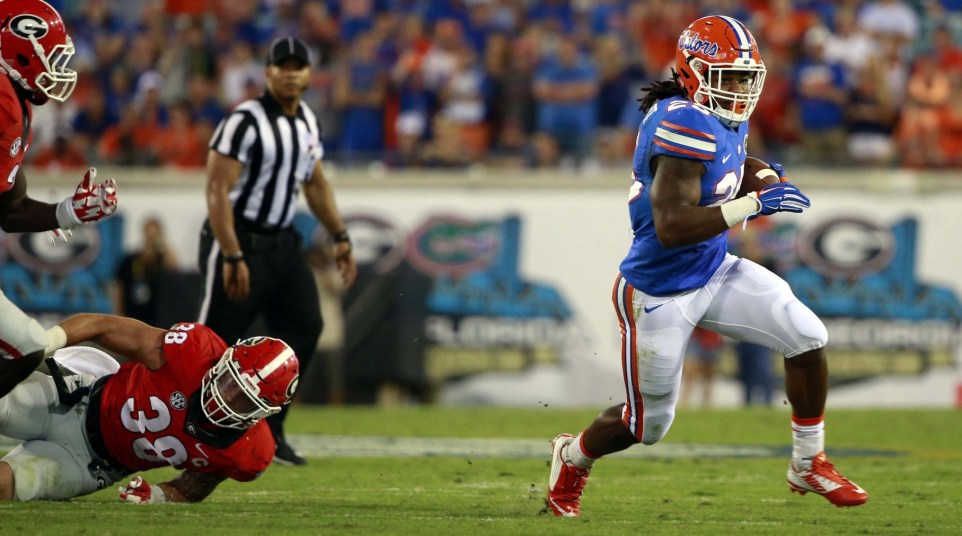
Can Jordan Scarlett be the Gators' home run back in 2016?
For a brief moment, it all came together – almost.
Florida had 2nd-and-7 from its own 34-yard line in the fourth quarter last year against Georgia when Jordan Scarlett took the handoff and saw the open field. He shot through the line of scrimmage, making one Bulldogs defender dive and miss. He bounced right off a second red jersey with a slight push.
At this point, he hit the gas and was off for the races.
But then, inside the UGA red zone, he made the freshman mistake of looking over his shoulder, losing a valuable step or two. He saw Bulldogs gunning for him with all their might and began to brace for impact, getting pushed out around the 6-yard line.
Jordan Scarlett (@Famousscarlett) showing why he was such a coveted recruit, explodes for the 60-yard run vs Georgia pic.twitter.com/7rCUDdOjev
— Nikko Tan (@TheNikkoTan) November 1, 2015
During the postgame press conference, coach Jim McElwain ribbed Scarlett for failing to score, saying, “When we recruited him, I thought he was fast.”
The speed is definitely there with Scarlett. In the 60-yard run, he shows a noticeable burst when he knows he’s in the open field. It’s pretty much guaranteed he has heard “don’t look over your shoulder, kid” enough times now for it to be hammered into his head going forward, but old habits can die hard.
Long runs aren’t easy to create, and a team needs to know that in those rare opportunities the ball-carrier will close the deal. If Scarlett had kept his eyes on the end zone and motored for the goal line, he probably scores, either crossing the line himself or extending the ball past the pylon on contact. And if so, it’s a 66-yard touchdown, which would have put Florida in the middle of the pack in the SEC for longest scoring runs.
But as the saying goes, almost doesn’t count in football. Following Scarlett’s run, the Gators committed a holding penalty. It was after that, somewhat ironically, that Florida logged it’s longest touchdown run of the season: a 16-yard carry by Kelvin Taylor.
Twelve other SEC teams had longer touchdown runs than the Gators in 2015:

Florida didn’t have some kind of recurring bad luck with long runs ending in the red zone, the fact is these long runs just weren’t happening often. The Gators finished near the bottom of the conference in runs exceeding 30 yards (No. 13, 4) and 40 yards (No. 10, 3). Runs exceeding 50 yards were rare in the SEC, but the Gators’ two qualifying rushes put them in a three-way tie for No. 8.
Whether those numbers change in 2016 could rest on Scarlett’s shoulders. As a freshman, the four-star signee logged only 34 total carries, or roughly 13 percent of Kelvin Taylor’s carries (259). With Taylor now on the San Francisco 49ers, Scarlett’s carries should increase significantly in 2016.

Credit: Kim Klement-USA TODAY Sports
McElwain and offensive coordinator Doug Nussmeier appear to be going with a committee approach at running back for 2016. At 6-foot-2, 242 pounds, Mark Thompson will be the power back and get the call on short-yardage situations. As an athlete with demonstrated good hands, Jordan Cronkrite will be the pass-catching back, and potentially an all-purpose utility back. Can Scarlett step up and become the group’s home run hitter, able to turn a 2nd-and-7 into a touchdown with one or two misses?
The Gators certainly need one.
